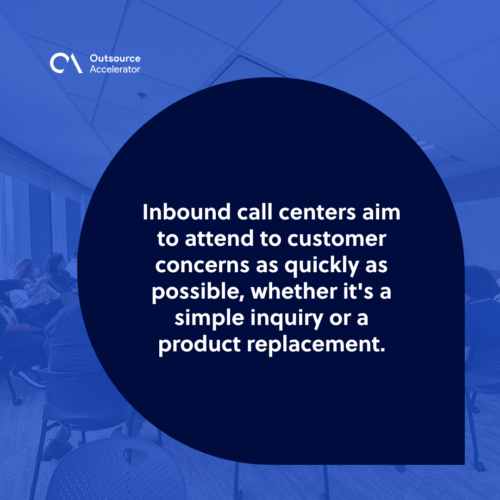Popular contact center outsourcing services to consider

Popular contact center outsourcing services
With everything becoming increasingly online, customers now look for easier ways to contact a business. They reach out through email, social media, or live chat about a product inquiry.
Some websites even use SMS to track updates and get customer feedback. All of these so they can have a great experience that they can get and increase customer satisfaction.
Outdated customer service can hurt a business badly. Customers can leave a brand, no matter how much they trust them, with a few bad experiences. Meanwhile, increasing bad reviews can have a huge impact on its reputation.
Luckily, there’s an ideal way to improve your customer experience by delegating contact center outsourcing services. Here’s a short manual of what you should know about it.
What is a contact center
A contact center is a business division that manages customer interaction. Unlike a traditional call center, they are more flexible in handling concerns and inquiries. They use different communication channels such as email, voice over internet phone (VoIP), and live chat.
A contact center can be hired in three ways: in-house, virtual, or outsourced.
Contact center vs. call center
These terms are usually mistaken for one another. It’s an understandable misconception as both usually overlap on one or two occasions.
A contact center offers services that encompass how organizations reach out to their clients, customers, and vice-versa. They pride themselves on having an omnichannel presence.
Like any other business, they offer multiple communication avenues to be more accessible.
On the other hand, a call center is a contact hub where the primary way of communication is by phone. Telemarketing, telesales, inbound, and outbound calls are usually the campaigns delegated in an outsourced call center.
Call center services can be a part of contact centers in general. Additionally, call center agents usually handle phone calls more than administrative tasks.

Contact center outsourcing defined
Contact center outsourcing, meanwhile, is the process of hiring contact center outsourcing companies for such services. The said provider covers everything needed to put up a dedicated team and takes care of the employees’ salaries, equipment, and tools for work.
Popular contact center services to outsource
Some of their popular services include the following.
Call center services
Call center outsourcing is still one of the most popular services in a contact center. They handle inbound, outbound, or mixed services depending on client needs.
When hiring a call center, businesses must predict the volume of calls they handle to determine the right service for them.
Inbound calls
Inbound services refer to handling incoming calls from customers. They usually deal with the following aspects.
- Customer inquiries and concerns
- Helpdesk
- Website navigation
Inbound call centers aim to attend to customer concerns as quickly as possible, whether it’s a simple inquiry or a product replacement.
This service usually measures how quickly call center agents answer a call, the number of minutes a customer is on hold, the total duration of their call, and how quickly the agent resolves an issue.
Outbound calls
Meanwhile, outbound call centers deal more with sales and marketing, lead generation, and billing. Their services include the following.
- Telemarketing
- Appointment confirmation
- Billing reminder
- Customer survey
- Market research
The main purpose of outbound services is to convert leads into potential sales opportunities, remind existing customers of billing and appointment dates, measure their satisfaction with the given service, and gather information for marketing plans and strategies.
Next to calls, email is the most used communication tool by customers.
Unlike call or live chat, email support usually takes up to a few days to be responded to.
Email communications can also be inbound, outbound, or both. Inbound is for inquiries, concerns, troubleshooting, and feedback.
Outbound service, meanwhile, is for sending newsletters, promo updates, billing, due date reminders, appointment confirmation, and customer satisfaction surveys.
Chat
Most websites have built-in chat support to attend to customers who are currently navigating it. Contact centers manage chatbots and live chats for concerns ranging from navigation to basic inquiries
Live chats can be combined with other communication channels for concerns beyond its limitations. This involves updating customer data, account activation and deactivation, and other technical concerns.
Popular contact center services to outsource
Social media
Live web and social media chats are considered the easiest way to instantly contact a business.
Nowadays, most customers are found on social media, with most of them buying from brands they follow on these platforms. This is why new and emerging small businesses bank on these platforms to reach a larger audience and improve customer experience.
With its popularity, contact centers use the platform to interact with customers. Its private messaging features allow customers to ask about delivery tracking and repair status, device troubleshooting, and inquiries on their accounts.

Pros and cons of contact center outsourcing services
Contact center outsourcing has many benefits compared to hiring an in-house team. Though it has its disadvantages as well, businesses come up with strategies to avoid these pitfalls.
Pros
Omnichannel or multichannel advantage
A contact center uses different channels beyond traditional calls. This gives advantages to companies looking to open more ways for customers to reach out to them.
More traffic balance
Especially during peak seasons, contact centers can balance the traffic more in case of increased traffic in different channels. No need to hire seasonal employees to keep up with the volume and traffic changes when needed.
Cost-effective
Contact center outsourcing services help businesses cut labor and equipment costs. This is because service providers already include these expenses in their offers.
24/7 service
Offshore contact centers offer 24/7 services to their clients. With this, they can guarantee business continuity even after office hours.
More focus on core duties
There’s no need to worry about handling customer service themselves. Outsourcing enables them to delegate these tasks to their team while they focus on the core management and strategies for business growth.
Cons
Security risks
Contact centers are the front liners in customer interaction. With this, they might be exposed to sensitive data such as customer records and business information while doing a transaction.
Lack of complete control
When a business outsources its contact center, they give the outsourcing company control of the operation. With the wrong company, they might sacrifice the quality of service they give to their customers.
Language barriers
Offshore teams may have a different accent than the customers, which can lead to misunderstanding. This can bring confusion and misunderstanding about resolving an issue from a customer.

Best countries for contact center outsourcing services
Below are the best countries you can choose for contact center outsourcing:
India
It is still the leading country in the world when it comes to the outsourcing of call center and technical support services, which most outsourcing companies here offer.
The country boasts its cheap labor cost, top-of-the-line equipment, high-quality service, and 24/7 support to its clients.
The Philippines
Leading next to India, the country highlights its strong English proficiency, hospitality, and westernized culture that make it more compatible with countries in the West.
The Philippines ranks fifth among all Southeast Asian countries with the most holidays in a year (21 Philippine holidays).
Poland
A humble country in Eastern Europe, Poland has gained popularity as the top country to outsource IT and IT-related services to their customers.
Most of their security services have guaranteed EU compliance, one of the reasons Western countries outsource their cybersecurity services to them.
Brazil
The amended outsourcing law of 2017 made it easier for Brazilians to work on primary services, such as office work. The country has become increasingly popular with tech support and IT-related services.
Ukraine
Last but not least, Ukraine is becoming popular in outsourcing IT services. The country boasts its cheap costs and the increasing rise of professionals enough to cater to outsourcing duties.
Best countries for contact center outsourcing services
Top contact center outsourcing companies worldwide
Aside from destination, choosing the right provider for your firm can also impact the quality and optimization of your contact center operations.
Here are the top contact center outsourcing companies you might want to consider.
OP360
OP360 is a premier BPO solutions provider offering nearshore and offshore services to startups and small brands in the US. They aim to help their clients achieve success through optimized customer experience and operations.
TaskUs
As a successful digital solutions provider, TaskUs helps clients get the best out of their contact center outsourcing solutions through digital customer experience.
Foundever
Foundever is a proud customer experience (CX) solutions leader for global organizations. They maintain the highest level of services, especially in contact center outsourcing services, by investing in employee experience and latest tools for their operations.
Are contact center outsourcing services worth the investment?
Instead of hiring in-house, you can opt to outsourcing customer service instead. Delegating these services to a business process outsourcing company can ease your burden of additional resources and legal requirements needed for your new employees.
Offshore companies can also help you cut labor costs by 70% while getting the best quality for your customers.
Offshoring to BPO providers like OP360 gives you a competitive edge as you will work with a vast pool of seasoned contact center agents. With OP360, you are guaranteed to boost your customer satisfaction while saving up on your financial resources!







 Independent
Independent




